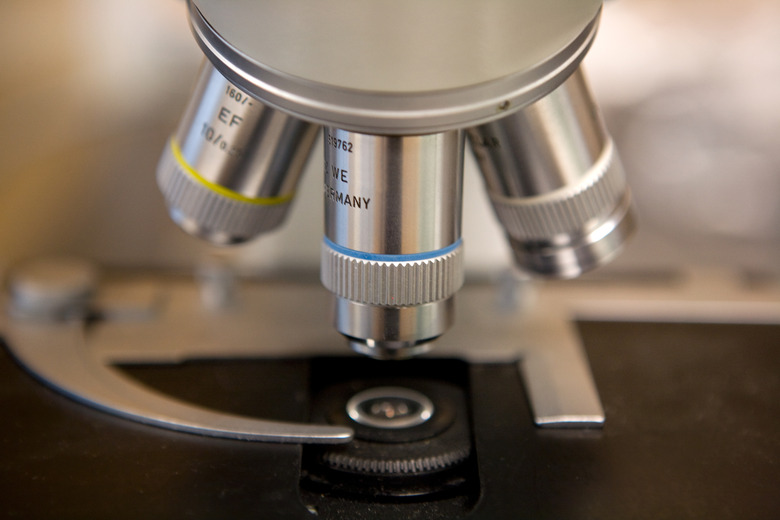What Is The Revolving Nosepiece On A Microscope?
The revolving nosepiece is an important part of a standard optical microscope. Used in classrooms and labs, the optical microscope is the most popular form of microscope due to its low cost relative to other types of microscopes as well as its simplicity. A user of an optical microscope should learn about the revolving nosepiece in order to properly use the microscope.
Location
Location
A microscope user will find the revolving nosepiece between the ocular lens (the eyepiece) and the stage (where the microscope holds slides and other objects for viewing). On most models, the revolving nosepiece attaches to the lower portion of the microscope's arm. The revolving nosepiece is round and generally has three or four cone-shaped lenses attached to it. The revolving nosepiece may have a serrated edge to assist the user in gripping and turning the nosepiece.
Purpose
Purpose
The revolving nosepiece holds multiple lenses, allowing the user to turn it to achieve various levels of magnification. Though the exact level of magnification may vary with different models, most microscopes provide a low power lens with about 5x magnification and a high power lens with about 100x magnification. This allows the user to locate objects using a low power lens and then examine the objects more closely with the high power one. If the microscope did not provide a revolving nosepiece, the microscope would only provide one level of magnification.
Use
Use
When observing an object with the microscope, the user starts with the lowest setting. When the user needs a higher magnification, the user turns the nosepiece to the next highest level. It is important to not turn the nosepiece by grasping the lenses as this may cause damage. Some microscopes provide a special lens that works with oil to provide a higher definition image. To use this lens, the user places immersion oil on top of the slide and puts the lens close to the slide. The oil forms a bond between the slide and the lens.
Care
Care
Through normal use, especially when using oil or water on a slide, the lenses attached to the revolving nosepiece may become dirty. The proper way to remove dust from the lenses is to use lens tissue to gently wipe the surface. Compressed air also can be used. Users should not blow on the lens or eyepiece to remove dust, as this can put moisture from the breath on the nosepiece and lenses. When using immersion oil, users should use lens tissue to wipe the oil from the lens, nosepiece and other parts of the microscope immediately after completing the viewing of the slide.
References
Cite This Article
MLA
Motes, Jay. "What Is The Revolving Nosepiece On A Microscope?" sciencing.com, https://www.sciencing.com/revolving-nosepiece-microscope-8715601/. 24 April 2017.
APA
Motes, Jay. (2017, April 24). What Is The Revolving Nosepiece On A Microscope?. sciencing.com. Retrieved from https://www.sciencing.com/revolving-nosepiece-microscope-8715601/
Chicago
Motes, Jay. What Is The Revolving Nosepiece On A Microscope? last modified March 24, 2022. https://www.sciencing.com/revolving-nosepiece-microscope-8715601/
